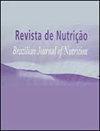有牛奶蛋白过敏胃肠道表现的婴儿的生长
IF 0.5
4区 医学
Q4 NUTRITION & DIETETICS
Revista De Nutricao-brazilian Journal of Nutrition
Pub Date : 2022-01-01
DOI:10.1590/1678-9865202235e210075
引用次数: 0
摘要
【摘要】目的评估胃肠门诊疑似牛奶蛋白过敏患儿的线性生长和体重增加情况。方法对2015年至2018年首次发现的84例婴儿进行回顾性队列研究,包括人口统计学、临床、人体测量学和饮食信息,并随访6个月。z分数中的年龄身高、年龄体重和年龄体重指数根据2006年世界卫生组织确定的分界点进行评估。加速增长或追赶被认为在参考指数的z-score中获得0.67,在3个月和6个月进行评估。结果基线时的中位年龄为4.0个月,88.1%的婴儿已经在饮食排除中。根据年龄体重指数和年龄体重指数进行的人体测量评估中,身高不足的比例分别为15.5%和8.3%,体重不足的比例分别为3.6%。在随访期间观察到高恢复增长,但不认为是追赶。在男孩中,年龄体重和年龄体重指数的增长是显著的(分别为p=0.02和p=0.01),接近追赶的阈值,分别为0.58和0.59。在女孩中,年龄比身高和年龄比体重显著增加(分别为0.38和0.37,p=0.02)。结论有胃肠道表现的疑似牛奶蛋白过敏患儿应尽早接受专门的营养咨询,避免接触致敏食物,控制过敏症状,从而避免营养不良,保证营养恢复。本文章由计算机程序翻译,如有差异,请以英文原文为准。
Growth of infants with gastrointestinal manifestations of cow’s milk protein allergy
ABSTRACT Objective To assess linear growth and weight gain in infants with suspected cow’s milk protein allergy with gastrointestinal manifestations, seen at a gastropediatrics clinic. Methods A retrospective cohort study conducted with demographic, clinical, anthropometric and dietary information on 84 infants first seen between 2015 and 2018 and followed-up for six months. Stature-for-age, weight-for-age, and body mass index-for-age in z-scores were evaluated according to the cut off points established by the World Health Organization in 2006. Accelerated growth or catch-up was considered a gain ?0.67 in the z-score of the referred indices, evaluated at 3 and 6 months. Results Median age at baseline was 4.0 months and 88.1% of the infants were already in diet exclusion. Regarding the anthropometric evaluation short stature frequency was 15.5% and the underweight frequency was 8.3% and 3.6% respectively based on the weight-for-age and body mass index-for-age indices. High recovery growth was observed during the follow-up period but was not considered catch up. In boys, the gains in weight-for-age and body mass index-for-age were significant (p=0.02 and p=0.01 respectively) and close to the threshold that characterizes the catch up, 0.58 and 0.59, respectively. In girls, significant gains in stature-for-age and weight-for-age (0.38 and 0.37 respectively, p=0.02 for both) were observed. Conclusion Infants with suspected cow’s milk protein allergy with gastrointestinal manifestations should have early access to specialized nutritional counseling to avoid exposure to allergenic food and control allergy symptoms, thereby avoiding malnutrition and ensuring adequate nutritional recovery.
求助全文
通过发布文献求助,成功后即可免费获取论文全文。
去求助
来源期刊
CiteScore
1.20
自引率
12.50%
发文量
24
审稿时长
6-12 weeks
期刊介绍:
Revista de Nutrição is former Revista de Nutrição da Puccamp, founded in 1988. It is a bimonthly publication every four months and it is of responsibility of the Centro de Ciências da Vida, da Pontifícia Universidade Católica de Campinas . It publishes articles that contribute to the study of Nutrition in its many sub-areas and interfaces; and is open to contributions of the national and international scientific communities.

 求助内容:
求助内容: 应助结果提醒方式:
应助结果提醒方式:


